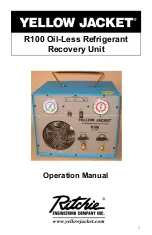
4
The 1 HP R100 offers significant flexibility
to meet your refrigerant handling needs in
a compact rugged, powder-coated case.
Careful handling of refrigerant is an
important part of servicing air-conditioning
and refrigeration equipment. Specific
regulations apply to refrigerant handling.
Familiarize yourself with these regula-
tions.
Because the refrigerant is combined in a
large tank, every technician must be sure
which refrigerant is in each tank. Your
company procedures should help you
determine this. Mixing refrigerants can
contaminate a large volume of refrigerant.
Use care when recovering refrigerant into
a portable tank. As stated in the warn-
ings, overfilling a tank can be extremely
dangerous. This unit is equipped with a
tank overfill sensor cord. When connected
properly to a recovery tank with a 80%
float, this device will shut off the unit when
the tank float activates (open contacts).
The R100 is designed for direct recovery
of liquid or vapor refrigerant. It can also
be used for the traditional push-pull, high
volume recovery of liquid refrigerant.
Recovery of liquid refrigerant in Vapor
Mode can damage the recovery unit com-
pressor. If you are not sure if liquid refrig-
erant is present, use the Liquid Mode.
OVERVIEW OF SYSTEM OPERATION
This unit should be operated by
certified personnel per 40 CFR part
82 subpart F or current equivalent.
Before operating this unit, please
read this manual thoroughly. You
must understand the procedures
outlined in this manual. Failure to
follow these procedures could void all
warranties.
Before handling refrigerants, read the
material safety data sheet (MSDS)
from the refrigerant manufacturer.
Inhalation of high concentration of
refrigerant vapors is harmful and may
cause heart irregularities, unconscious-
ness, or death. Deliberate inhalation of
refrigerants is extremely dangerous.
Death can occur without warning. Vapors
reduce oxygen available for breathing and
are heavier than air. Decomposition
products are hazardous. Liquid contact
can cause frostbite. All refrigerant
containers, equipment, and hoses contain
high pressure.
Contact with refrigerant can cause
frostbite.
CAUTION! WARNING!
FIRST AID:
If high concentrations of refrig-
erant are inhaled, immediately remove the
victim to fresh air. Call a physician or
emergency medical technician. Keep calm.
If the victim is not breathing, give artificial
respiration. If breathing is difficult, give
oxygen. Do not give epinephrine or similar
drugs.
EYE:
In case of liquid contact, imme-
diately flush eyes with plenty of water.
Call a physician.
SKIN:
Flush with water. Treat for
frostbite, if necessary, by gently
warming the effected area.
CAUTION!
All refrigerant hoses, recovery
tanks, refrigerant lines, the R100, and other
vessels containing refrigerants should be
handled as if under high pressure.
GENERAL SAFETY INSTRUCTIONS, cont.












